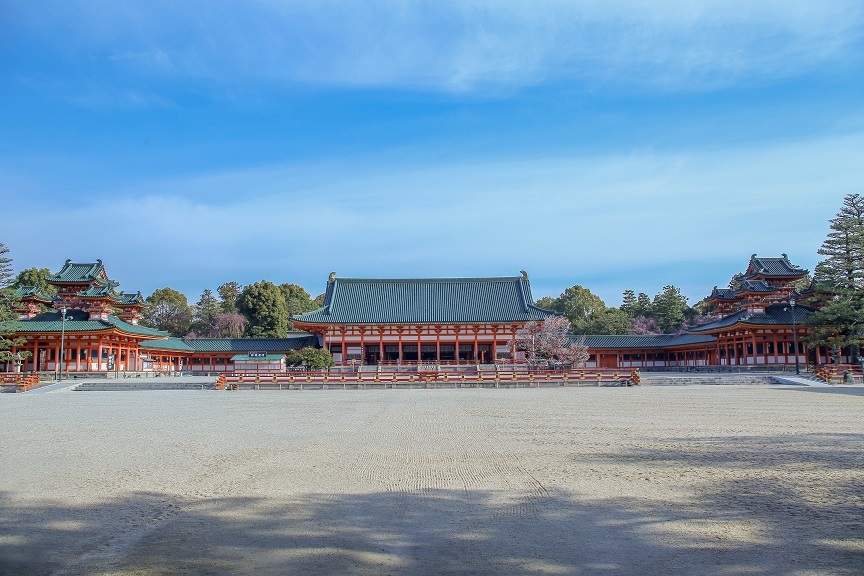Introduction
Heian Shrine (平安神宮, Heian Jingū), though relatively young, stands as an unmissable cultural gem in Kyoto. Built in 1895, this shrine not only commemorates Kyoto’s glorious history as Japan’s ancient capital but also offers a perfect glimpse into imperial grandeur. This guide will take you through the allure of Heian Shrine, showcasing its unique architecture, stunning garden landscapes, and rich historical significance.
Heian Shrine at a Glance
- Established in 1895 to mark the 1100th anniversary of Kyoto’s founding
- Dedicated to the first and last emperors who reigned from Kyoto
- Designed as a scaled-down replica of the ancient Imperial Palace
- Features a massive torii gate and spacious courtyard
- Houses a beautiful garden famous for late-blooming cherry blossoms
- Hosts the annual Jidai Festival on October 22nd
Delving into History
Despite its relatively short history of just over a century, Heian Shrine embodies Kyoto’s millennial legacy as an ancient capital. The shrine is dedicated to Emperor Kammu (737-806), who initiated the Heian Period, and Emperor Komei (1831-1867), who witnessed the end of the shogunate era. “Heian” was the old name for Kyoto, emphasizing the shrine’s deep connection to the city’s history.
The shrine’s architectural style replicates that of the Heian Period Imperial Palace, albeit on a slightly smaller scale. This not only pays homage to the city’s glorious past but also provides modern visitors with a window into ancient court life.
Main Attractions of Heian Shrine
1. The Imposing Great Torii Gate
The shrine’s iconic structure, a towering vermilion torii gate, serves as the first portal for visitors. This gate is not only a perfect photo spot but also symbolizes the transition from the secular to the sacred realm.
2. The Spacious Shrine Grounds
Beyond the torii gate lies an expansive courtyard. This open space allows visitors to fully appreciate the shrine’s architectural complex and serves as an ideal venue for various traditional ceremonies and festival events.
3. The Elegant Main Hall
The shrine’s main buildings, a harmonious blend of vermilion and white, perfectly recreate the architectural style of the Heian Period Imperial Palace. Visitors can closely observe the intricate designs of ancient court architecture.
4. The Breathtaking Garden
The paid garden behind the main shrine buildings is a must-visit highlight. It’s renowned for its numerous weeping cherry trees, which bloom in mid-April, making it a popular late-season cherry blossom viewing spot in Kyoto. Beyond spring, the garden offers unique beauty in every season.
Best Time to Visit
- Spring (late March to mid-April): Ideal for viewing the weeping cherry blossoms
- Autumn (October): Enjoy fall foliage and the chance to experience the Jidai Festival
- Year-round: Each season offers its unique charm
Getting There
From Kyoto Station:
- Take Kyoto City Bus number 5, approximately 30 minutes (230 yen)
- Or take the subway to Higashiyama Station (via Karasuma Oike Station, 20 minutes, 260 yen), then walk 10 minutes
Hours and Admission
Heian Shrine:
- Hours: 6:00-17:00/18:00 (varies slightly by season)
- Admission: Free
Garden:
- Hours: 8:30-16:30/17:30 (varies slightly by season)
- Admission: 600 yen
Visitor Tips
- Allow ample time to explore the garden, especially during cherry blossom season
- Plan ahead if you wish to attend the Jidai Festival on October 22nd
- Wear comfortable shoes as the shrine and garden areas are extensive
- Bring small change for purchasing omamori (charms) or ema (wooden prayer plaques)
- Respect local customs by maintaining quiet and refraining from photography inside main shrine buildings
Official Website
Conclusion
Heian Shrine is more than just a beautifully constructed shrine; it’s a time portal connecting modern visitors to ancient Kyoto. Whether you’re a history enthusiast, an architecture buff, or simply a traveler eager to experience traditional Japanese culture, Heian Shrine is a must-visit destination. As you cross the majestic torii gate and stroll through the expansive grounds, you’ll feel the essence of Kyoto’s thousand-year legacy. Let’s embark on this journey through time at Heian Shrine and experience the eternal beauty of Kyoto.
